Micro Turbojet Engine Nozzle Ejector Impact on the Acoustic Emission, Thrust Force and Fuel Consumption Analysis
Abstract
:1. Introduction
2. Materials and Methods
2.1. Experimental Test Bench
2.2. Design and Optimization of the Ejector Jet
2.3. Ejector Nozzle Manufacturing
3. Results and Discussions
3.1. Engine Performance
3.1.1. Stable Operational States of the Engine Performance
3.1.2. Transient Performance
3.2. Acoustic Evaluation Results
4. Conclusions
Author Contributions
Funding
Institutional Review Board Statement
Informed Consent Statement
Data Availability Statement
Conflicts of Interest
References
- Guercio, V.; Pojum, I.C.; Leonardi, G.S.; Shrubsole, C.; Mac Gowers, A.; Dimitroulopoulou, S.; Exley, K.S. Exposure to indoor and outdoor air pollution from solid fuel combustion and respiratory outcomes in children in developed coun-tries: A systematic review and meta-analysis. Sci. Total. Environ. 2021, 755, 142187. [Google Scholar] [CrossRef] [PubMed]
- European Union Aviation Safety Agency. European Aviation Environmental Report; European Union Aviation Safety Agency: Köln, Germany, 2019.
- Bogdanov, D.; Gulagi, A.; Fasihi, M.; Breyer, C. Full energy sector transition towards 100% renewable energy supply: Integrating power, heat, transport and industry sectors including desalination. Appl. Energy 2021, 283, 116273. [Google Scholar] [CrossRef]
- Gössling, S.; Humpe, A. The global scale, distribution and growth of aviation: Implications for climate change. Glob. Environ. Chang. 2020, 65, 102194. [Google Scholar] [CrossRef]
- Zhao, K.; Okolo, P.; Neri, E.; Chen, P.; Kennedy, J.; Bennett, G. Noise reduction technologies for aircraft landing gear—A bibliographic review. Prog. Aerosp. Sci. 2020, 112, 100589. [Google Scholar] [CrossRef]
- Torija, A.; Self, R. Aircraft classification for efficient modelling of environmental noise impact of aviation. J. Air Transp. Manag. 2018, 67, 157–168. [Google Scholar] [CrossRef]
- Cican, G.; Deaconu, M.; Mirea, R.; Ceatra, L.C.; Cretu, M. An Experimental Investigation to Use the Biodiesel Resulting from Recycled Sunflower Oil, and Sunflower Oil with Palm Oil as Fuels for Aviation Turbo-Engines. Int. J. Environ. Res. Public Health 2021, 18, 5189. [Google Scholar] [CrossRef]
- Zhang, H.; Fang, Y.; Wang, M.; Appels, L.; Deng, Y. Prospects and perspectives foster enhanced research on bio-aviation fuels. J. Environ. Manag. 2020, 274, 111214. [Google Scholar] [CrossRef]
- Cican, G.; Toma, A.; Puşcaşu, C.; Catana, R. Jet CAT P80 thermal analyses and performance assessment using different fuels types. J. Therm. Sci. 2018, 27, 389–393. [Google Scholar] [CrossRef]
- Hoelzen, J.; Silberhorn, D.; Zill, T.; Bensmann, B.; Hanke-Rauschenbach, R. Hydrogen-powered aviation and its reliance on green hydrogen infrastructure—Review and research gaps. Int. J. Hydrog. Energy 2022, 47, 3108–3130. [Google Scholar] [CrossRef]
- Petrescu, R.V.; Machín, A.; Fontánez, K.; Arango, J.; Márquez, F.; Petrescu, F.I. Hydrogen for aircraft power and propulsion. Int. J. Hydrog. Energy 2020, 45, 20740–20764. [Google Scholar] [CrossRef]
- Pelz, P.; Leise, P.; Meck, M. Sustainable aircraft design—A review on optimization methods for electric propulsion with derived optimal number of propulsors. Prog. Aerosp. Sci. 2021, 123, 100714. [Google Scholar] [CrossRef]
- Dahal, K.; Brynolf, S.; Xisto, C.; Hansson, J.; Grahn, M.; Grönstedt, T.; Lehtveer, M. Techno-economic review of alternative fuels and propulsion systems for the aviation sector. Renew. Sustain. Energy Rev. 2021, 151, 111564. [Google Scholar] [CrossRef]
- Cican, G. Marius Deaconu and Daniel-Eugeniu Crunteanu, Impact of Using Chevrons Nozzle on the Acoustics and Performances of a Micro Turbojet Engine. Appl. Sci. 2021, 11, 5158. [Google Scholar] [CrossRef]
- Crispo, C.M.; Greco, C.S.; Cardone, G. Flow field features of chevron impinging synthetic jets at short nozzle-to-plate distance. Exp. Therm. Fluid Sci. 2019, 106, 202–214. [Google Scholar] [CrossRef]
- Ferrante, P.; De Roeck, W.; Desmet, W.; Magnino, N. Back-to-back comparison of impedance measurement techniques applied to the characterization of aero-engine nacelle acoustic liners. Appl. Acoust. 2016, 105, 129–142. [Google Scholar] [CrossRef]
- Sadeghian, M.; Bandpy, M.G. Technologies for aircraft noise reduction: A review. J. Aeronaut. Aerosp. Eng. 2020, 9, 219. [Google Scholar]
- Liu, X.; Zhao, D.; Guan, D.; Becker, S.; Sun, D.; Sun, X. Development and progress in aeroacoustic noise reduction on turbofan aeroengines. Prog. Aerosp. Sci. 2022, 130, 100796. [Google Scholar] [CrossRef]
- Kracik, J.; Dvorak, V. Secondary flow choking in axisymmetric supersonic air ejector with adjustable mo-tive nozzle. Appl. Therm. Eng. 2022, 204, 117936. [Google Scholar] [CrossRef]
- Keenan, J.H.; Neumann, E.P.; Lustwerk, F. An Investigation of Ejector Design by Analysis and Experiment. J. Appl. Mech. 1950, 17, 299–309. [Google Scholar] [CrossRef]
- Zhang, Z.; Wang, C.; Yang, S.; Cheng, F.; Geng, J.; Yang, Z.; Lyu, Y.; Yu, L. Research on performance of multi-nozzle ejector for aeroengine air system. Therm. Sci. Eng. Prog. 2023, 38, 101651. [Google Scholar] [CrossRef]
- Zhang, Z.; Feng, X.; Tian, D.; Yang, J.; Chang, L. Progress in ejector-expansion vapor com-pression refrigeration and heat pump systems. Energy Convers. Manag. 2020, 207, 112529. [Google Scholar] [CrossRef]
- Available online: https://aviation.stackexchange.com/questions/37332/what-is-this-ring-shaped-device-behind-this-dc-8s-jet-engine (accessed on 10 July 2021).
- Jack, C.; Ned, A. The Engines of Pratt & Whitney: A Technical History; American Institute of Aeronautics and Astronautics: Reston, VA, USA, 1020; pp. 321–333. ISBN 9781-60086-711-8. [Google Scholar]
- Peng, C.; Fan, W.; Zhang, Q.; Yuan, C.; Chen, W.; Yan, C. Experimental study of an air-breathing pulse detonation engine ejector. Exp. Therm. Fluid Sci. 2011, 35, 971–977. [Google Scholar]
- Shi, L.; Zhao, G.; Yang, Y.; Qin, F.; Wei, X.; He, G. Experimental study on ejector-to-ramjet mode transition in a divergent kerosene-fueled RBCC combustor with low total temperature inflow. Aerosp. Sci. Technol. 2020, 99, 105734. [Google Scholar] [CrossRef]
- Shi, L.; Zhao, G.; Yang, Y.; Gao, D.; Qin, F.; Wei, X.; He, G. Research progress on ejec-tor mode of rocket-based combined-cycle engines. Prog. Aerosp. Sci. 2019, 107, 30–62. [Google Scholar] [CrossRef]
- Chen, H.; Zhang, H.; Xi, Z.; Zheng, Q. Modeling of the turbofan with an ejector nozzle based on infrared prediction. Appl. Therm. Eng. 2019, 159, 113910. [Google Scholar] [CrossRef]
- Khalid, S.; Sokhey, J.; Chakka, P.; Pierluissi, A. Ejector/Engine/Nacelle Integration for Increased Thrust minus Drag. In Proceedings of the 46th AIAA/ASME/SAE/ASEE Joint Propulsion Conference & Exhibit, Nashville, TN, USA, 25–28 July 2010. [Google Scholar]
- Schmidt, R.; Hupfer, A. Design and numerical simulation of ejector nozzles for very small turbojet engines. CEAS Aeronaut. J. 2021, 12, 923–940. [Google Scholar] [CrossRef]
- Tashtoush, B.M.; Al-Nimr, M.A.; Khasawneh, M.A. A comprehensive review of ejector design, performance, and applications. Appl. Energy 2019, 240, 138–172. [Google Scholar] [CrossRef]
- Jet Cat USA. Jet Cat Instruction Manual. U.S. Patent 6216440, 17 April 2001.
- Constantinescu, V.; Galetuse, S. Mecanica Fluidelor si Elemente de Aerodinamica; Editura Didactica si Pedagogica: Bucuresti, Romania, 1983. [Google Scholar]
- Dong, Z.; Sun, M.; Wang, Z.; Cai, Z.; Yao, Y.; Gu, R. Numerical investigation on flow and mixing characteristics inside a converging-diverging mixing duct of rocket-based combined-cycle engine in ejector mode. Aerosp. Sci. Technol. 2020, 106, 106102. [Google Scholar] [CrossRef]
- Zhang, K.; Zhu, X.; Ren, X.; Qiu, Q.; Shen, S. Numerical investigation on the effect of nozzle position for design of high performance ejector. Appl. Therm. Eng. 2017, 126, 594–601. [Google Scholar] [CrossRef]
- Ye, W.; Zhang, J.; Xu, W.; Zhang, Z. Numerical investigation on the flow structures of the multistrut mixing enhancement ejector. Appl. Therm. Eng. 2020, 179, 115653. [Google Scholar] [CrossRef]
- Mattingly, J. Elements of Propulsion: Gas Turbines and Rockets, 2nd ed.; American Institute of Aeronautics and 557 Astronautics: Reston, VA, USA, 2006. [Google Scholar]
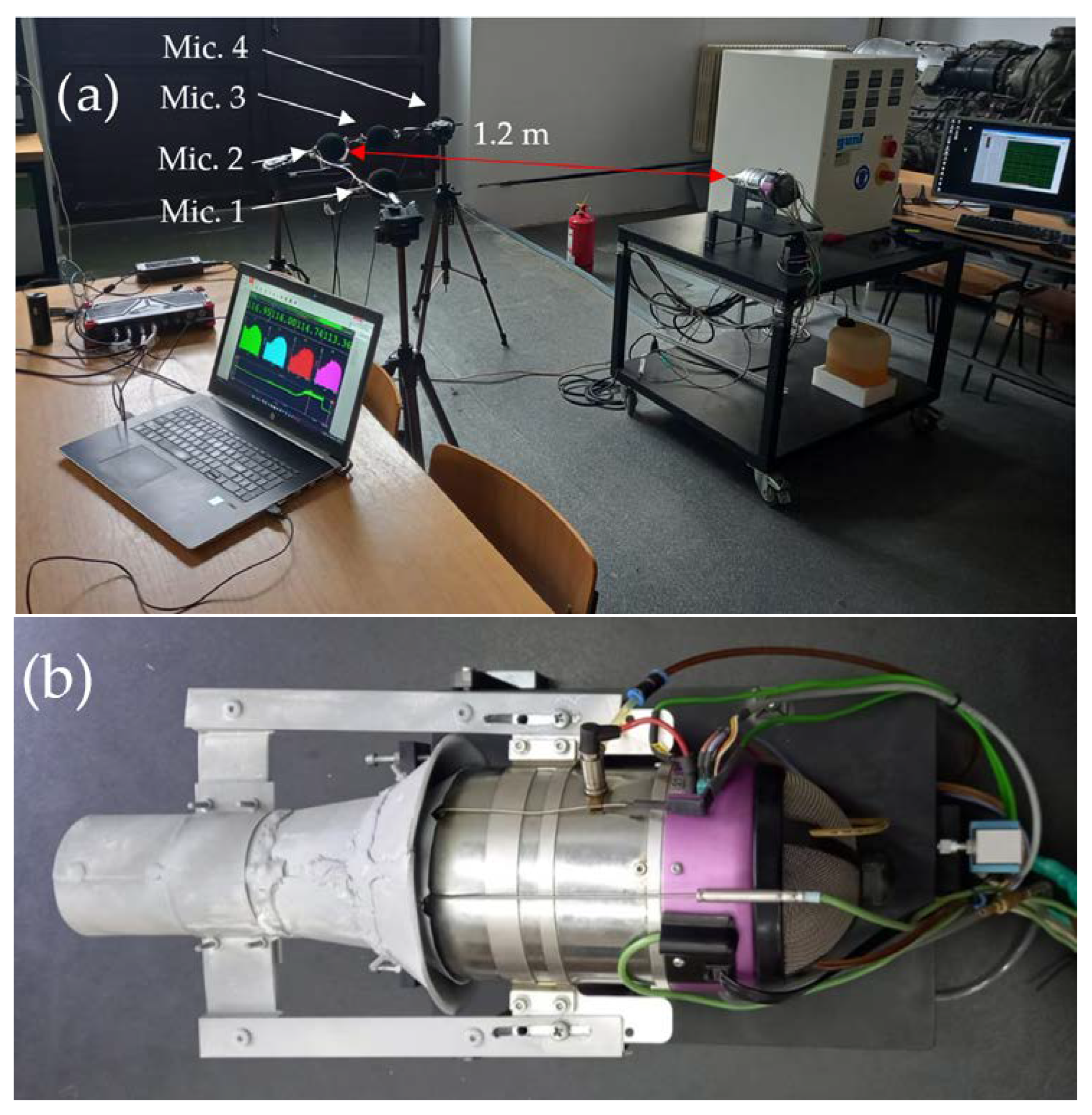
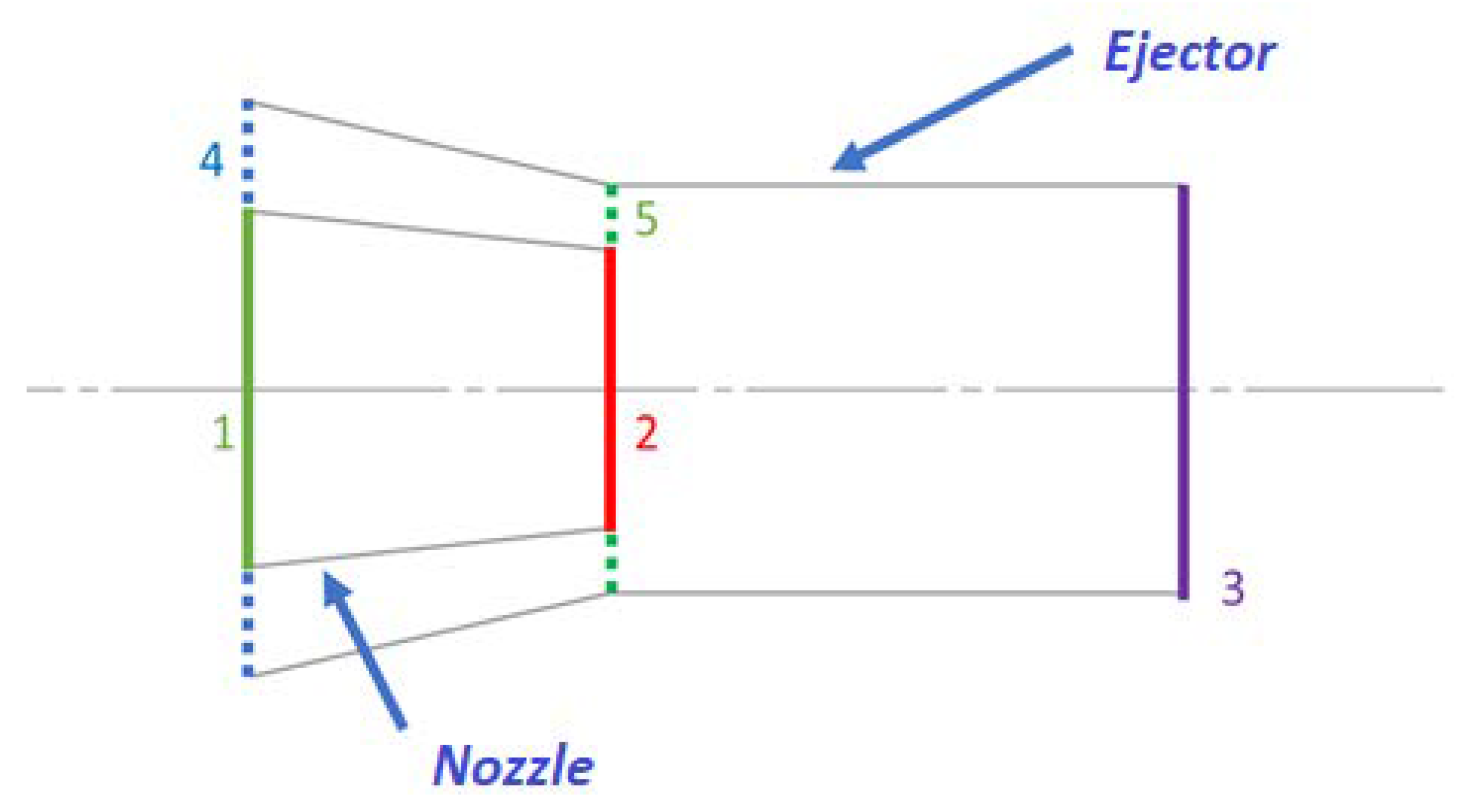
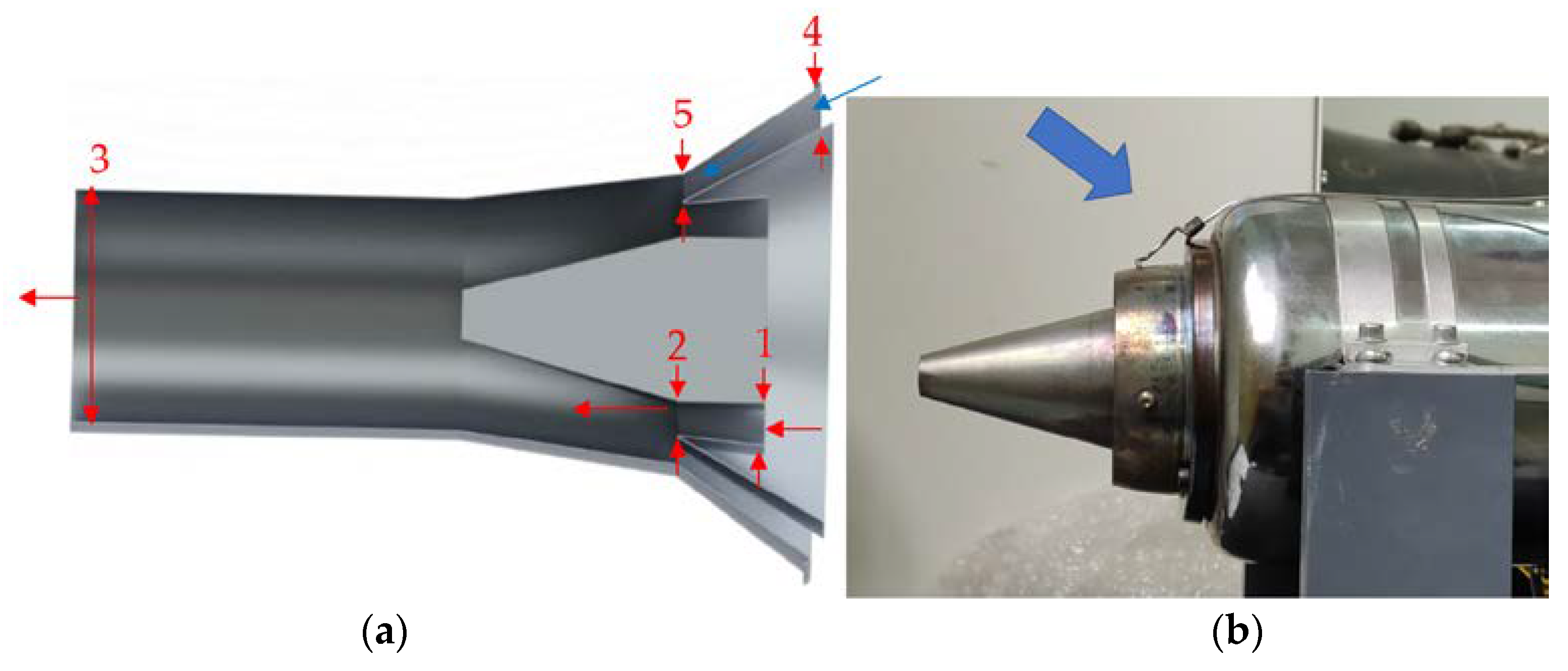


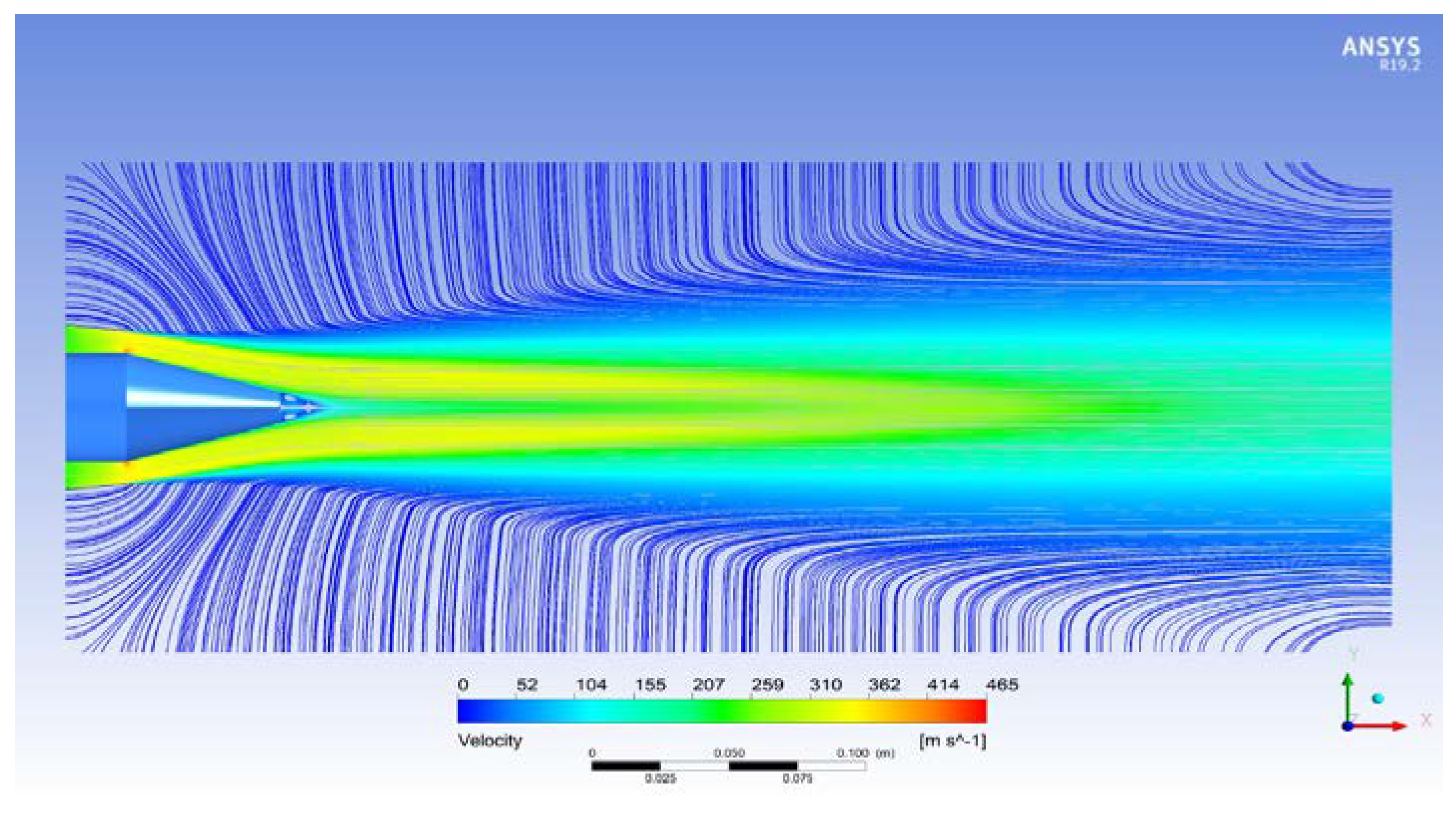
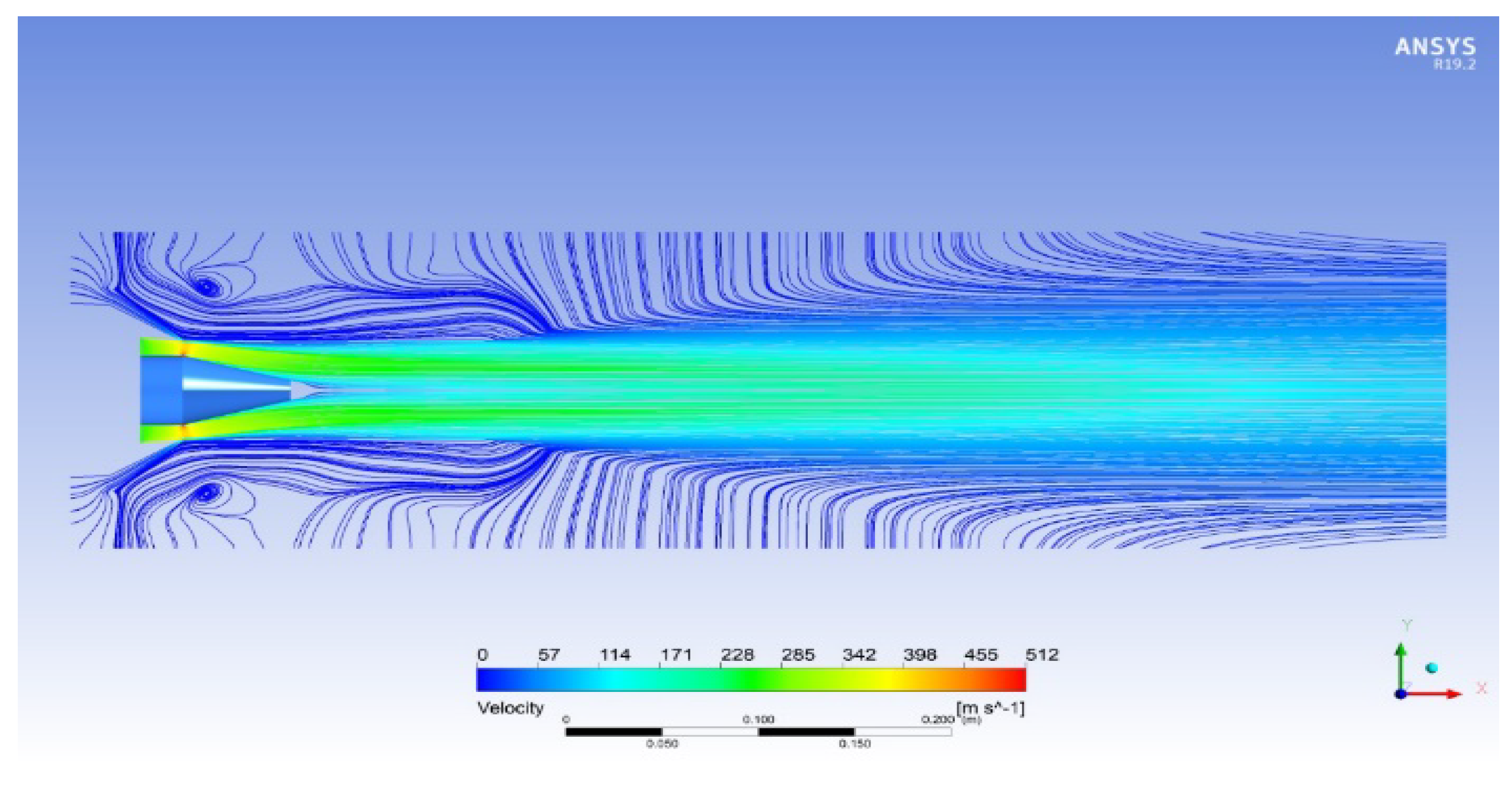
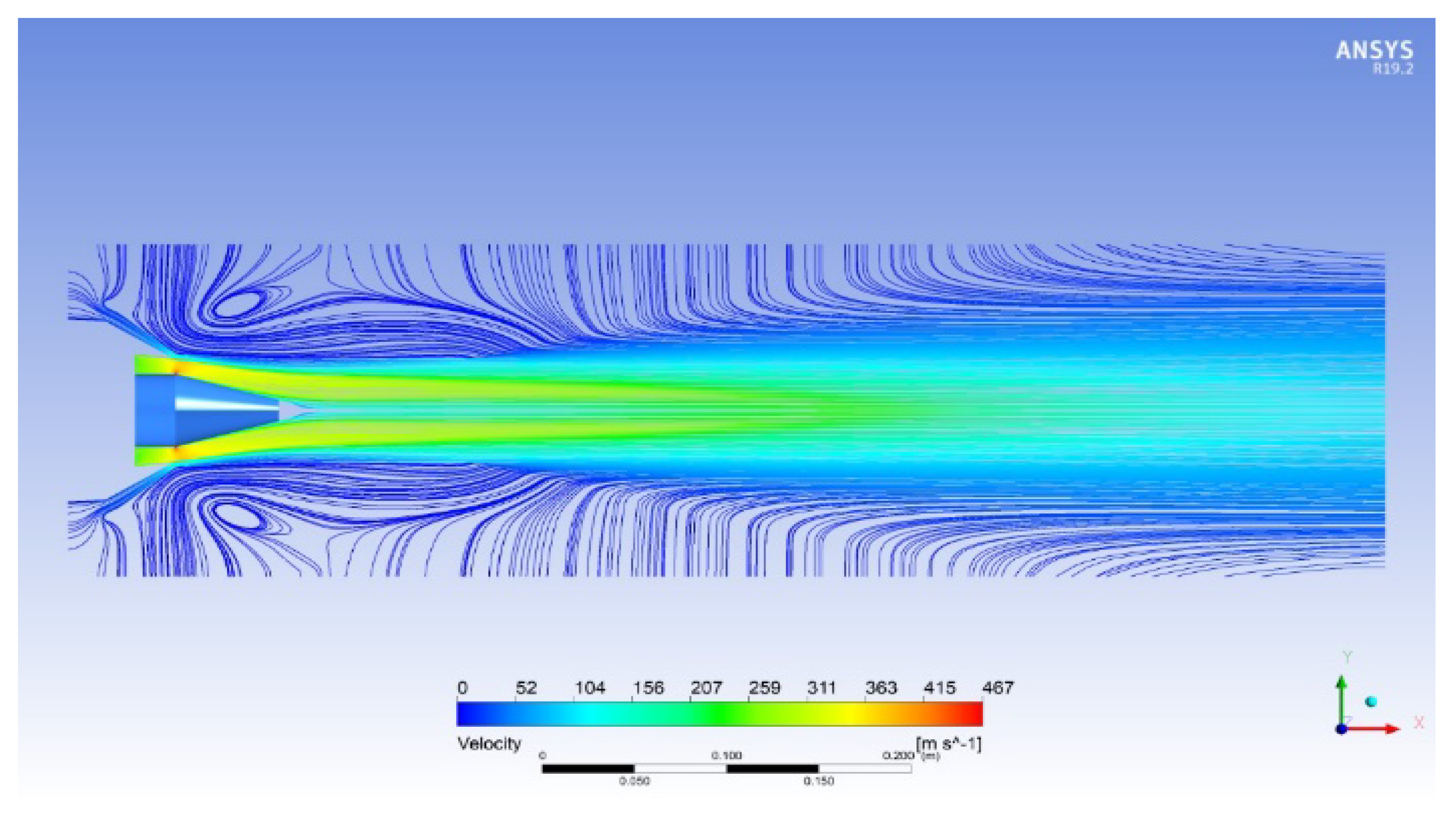

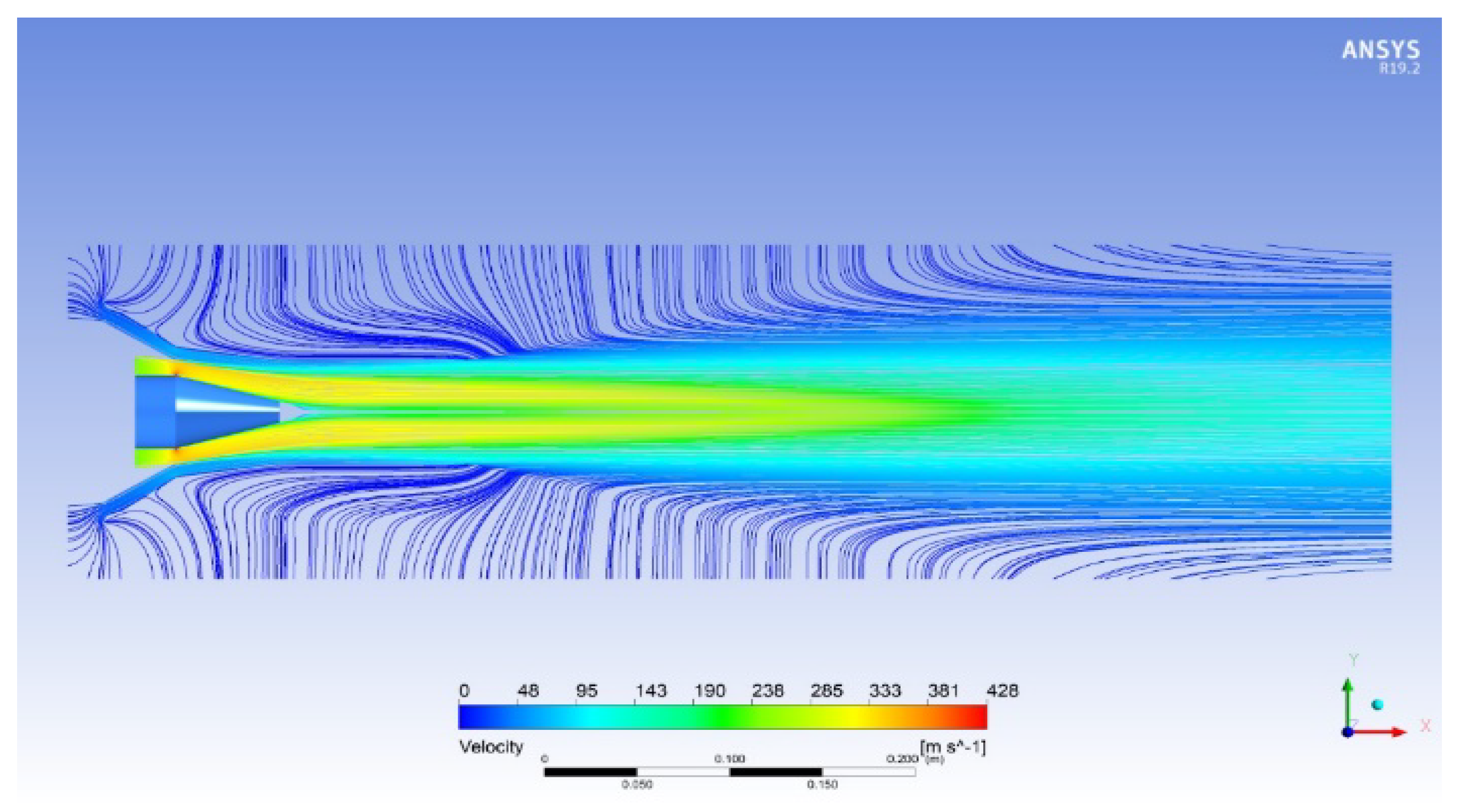
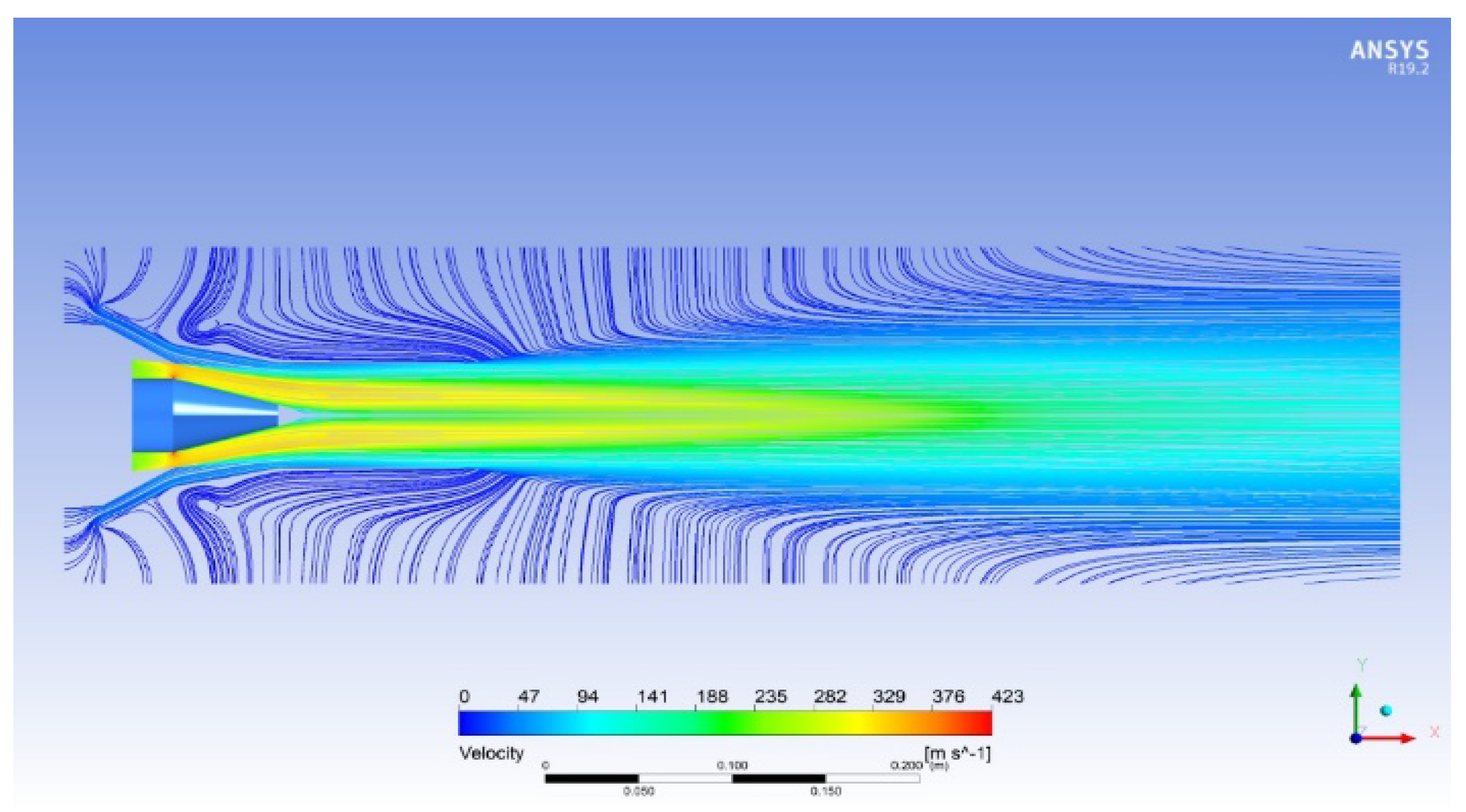
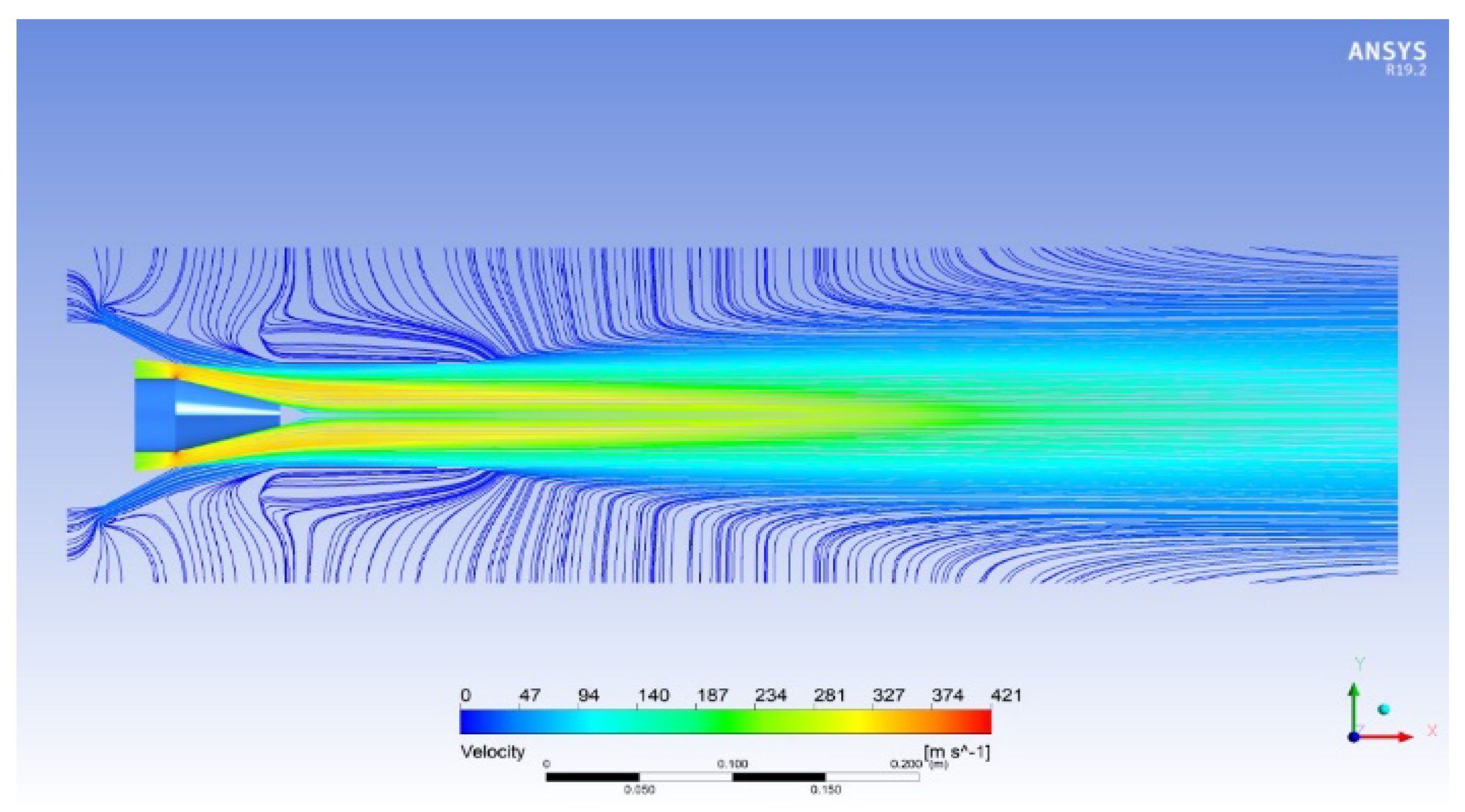
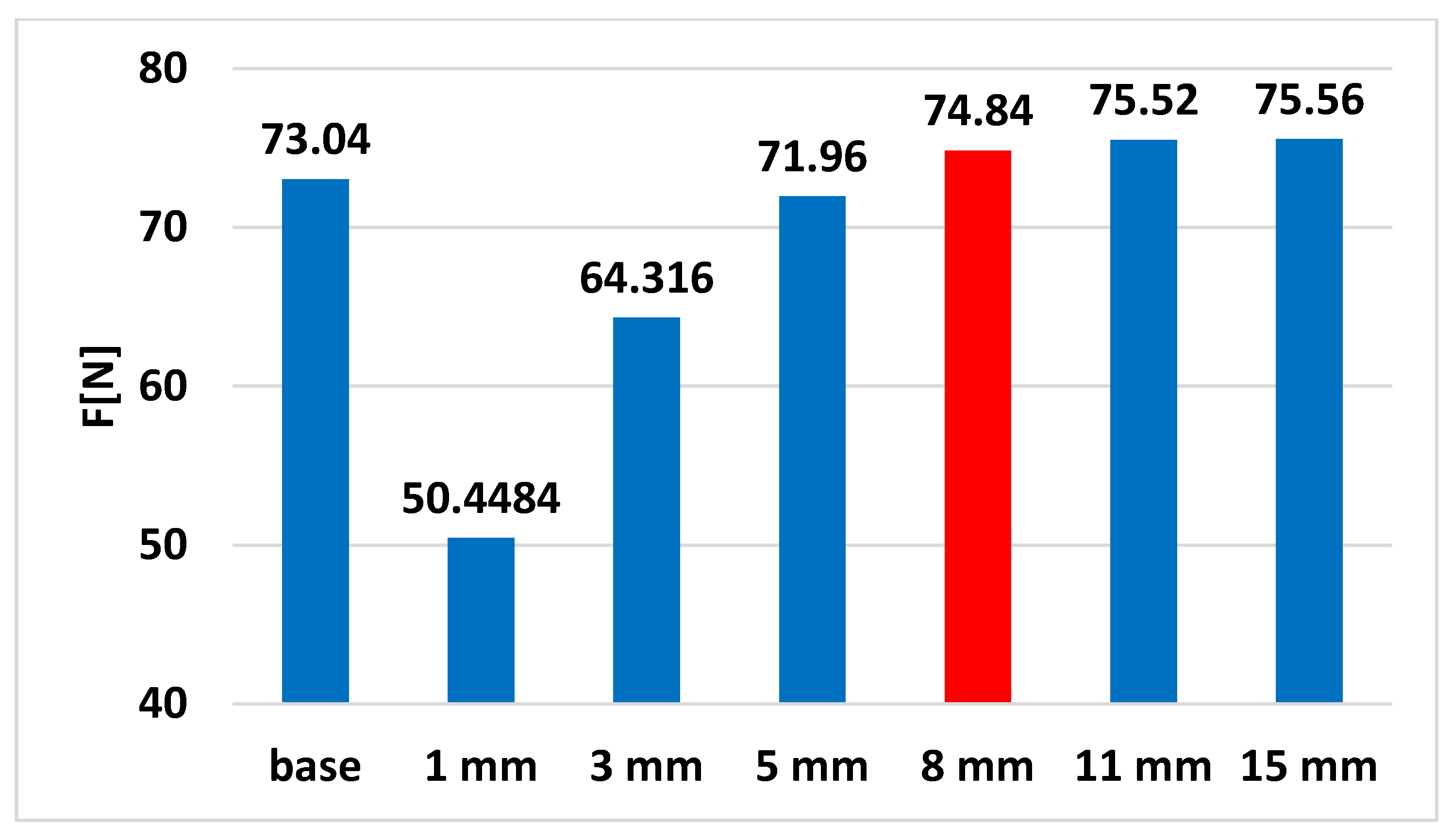
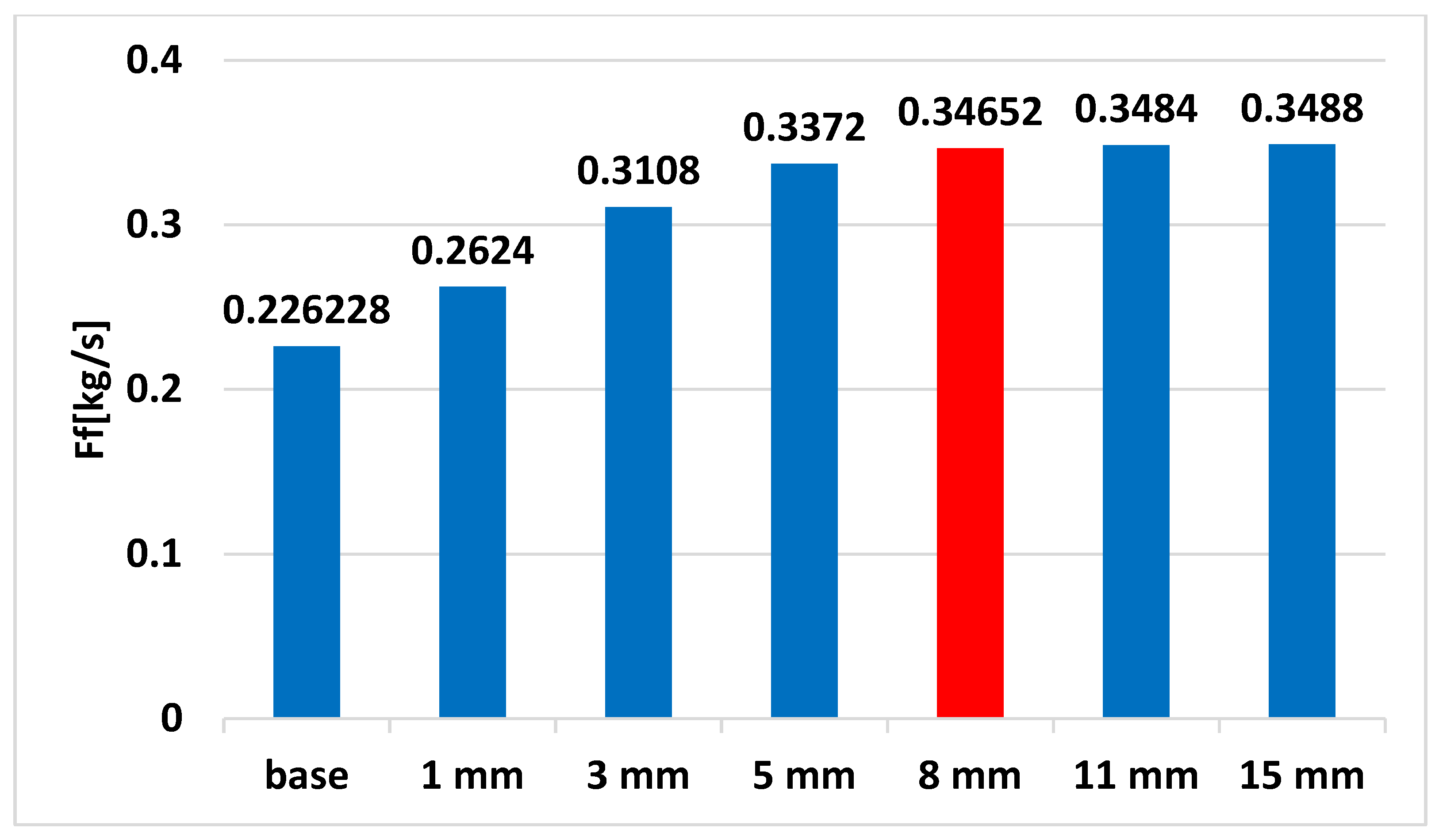
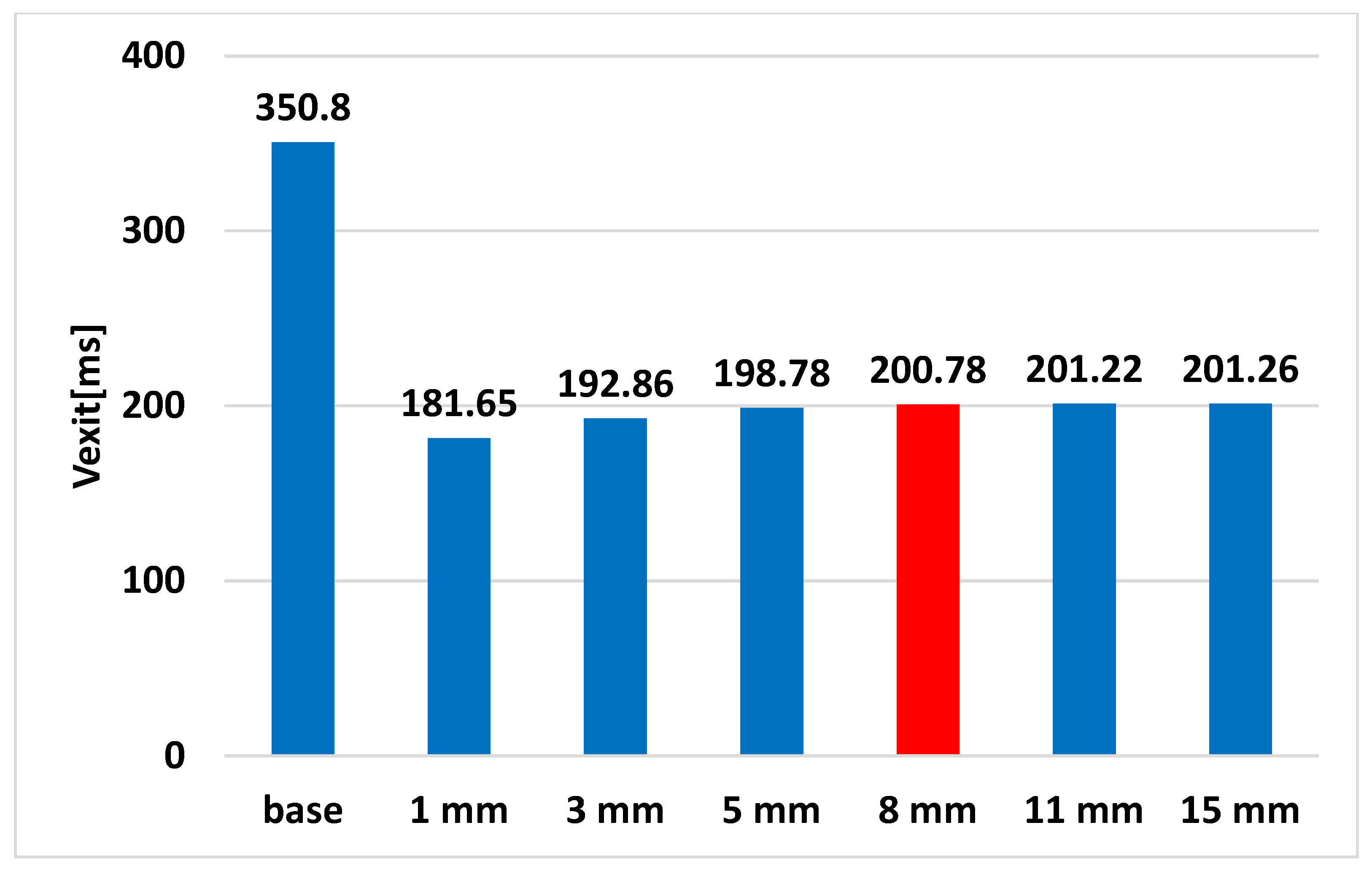
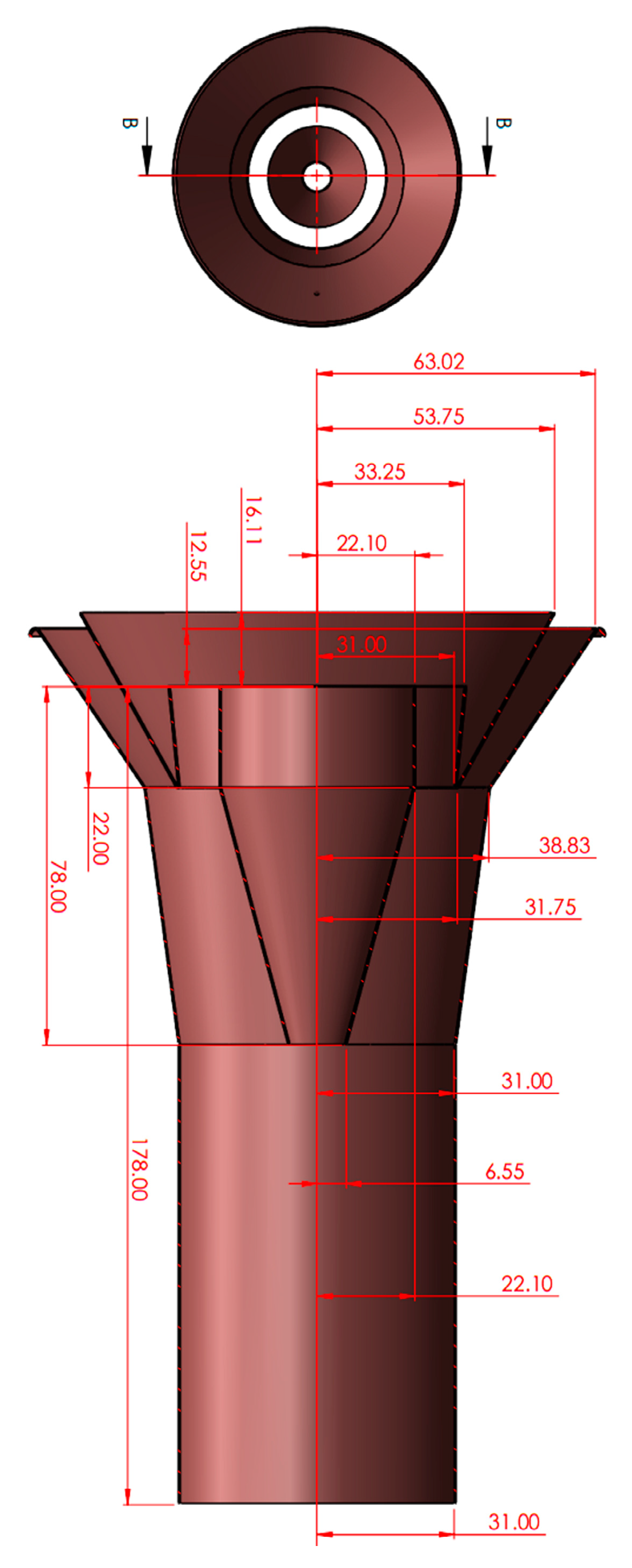
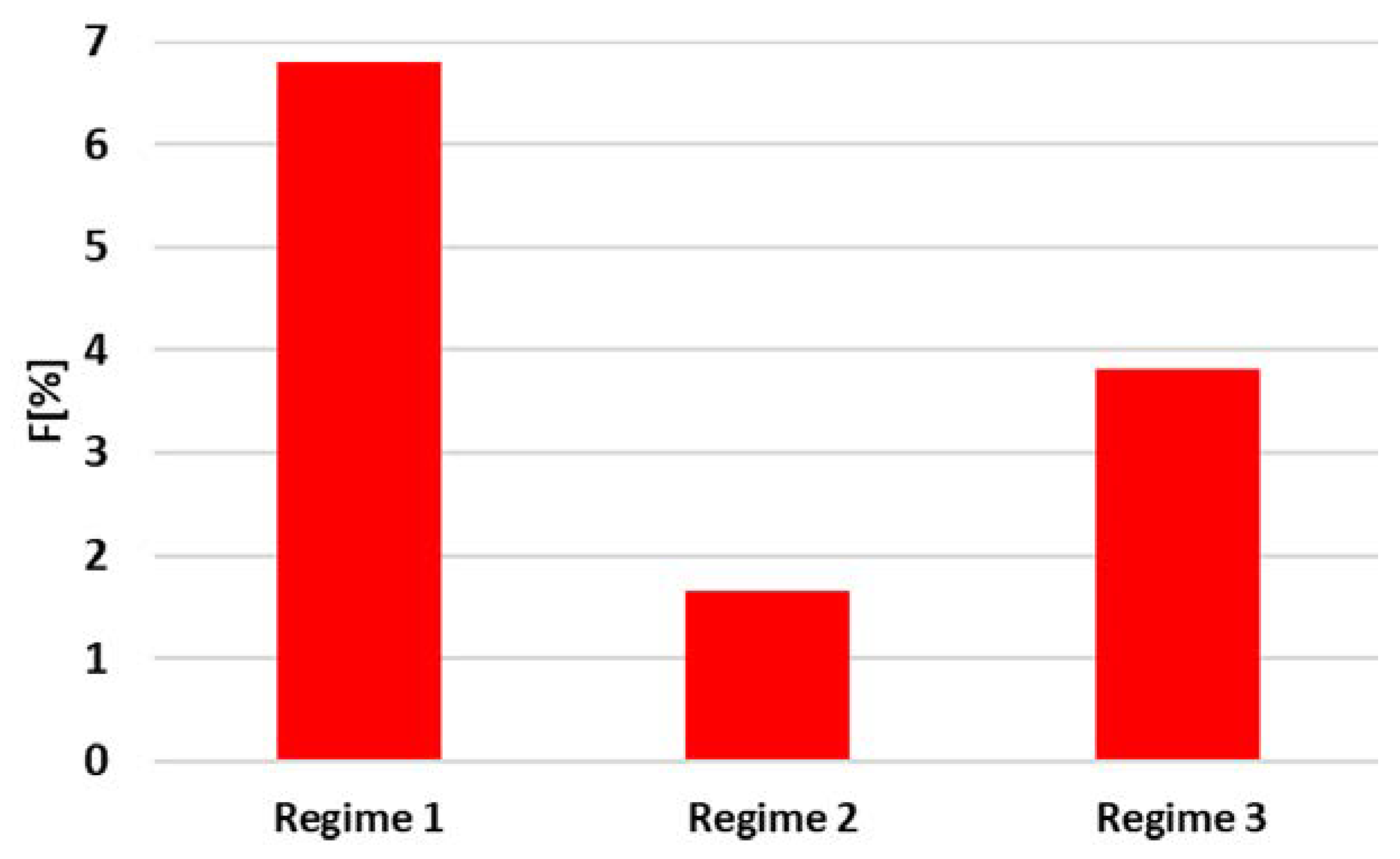
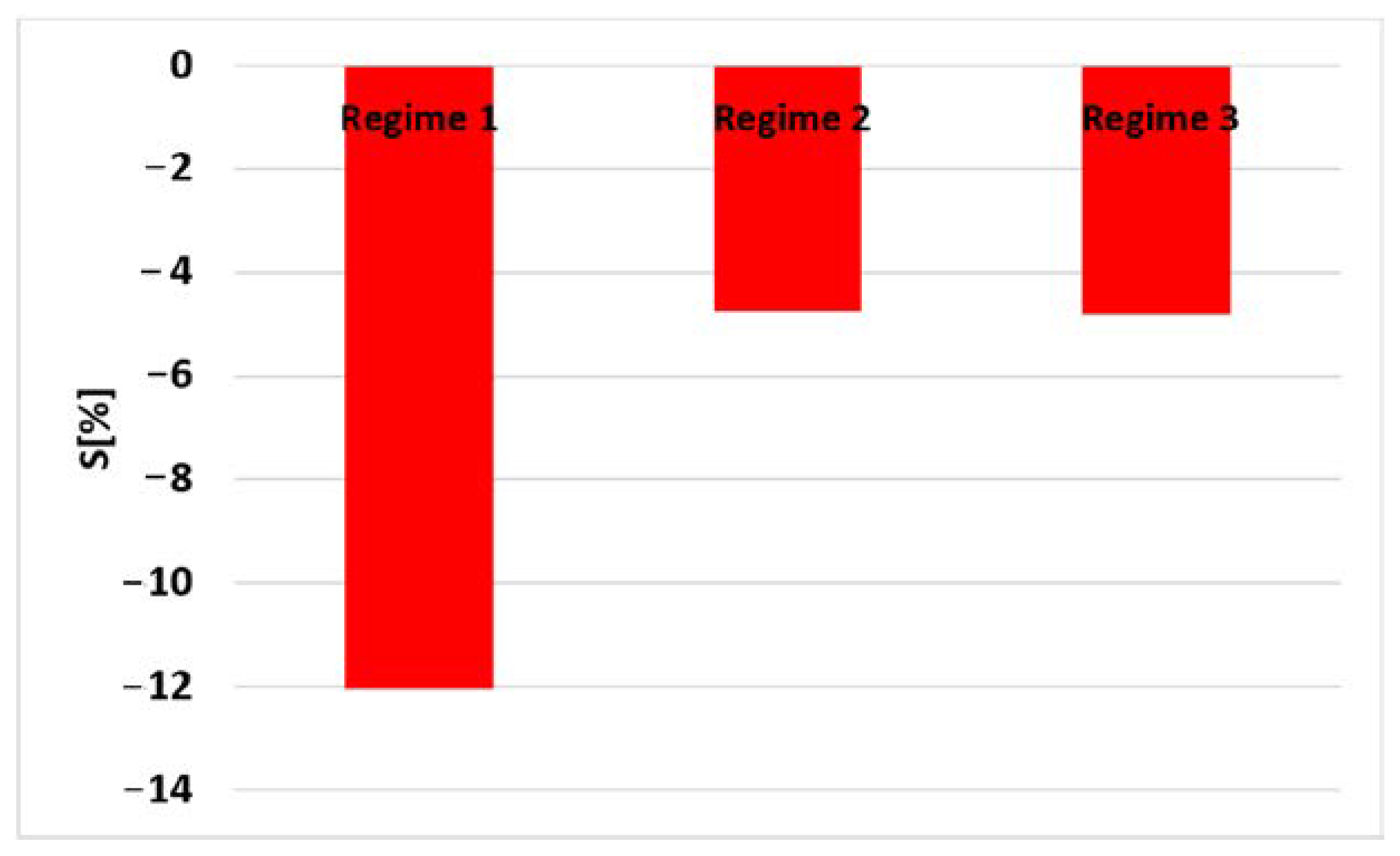

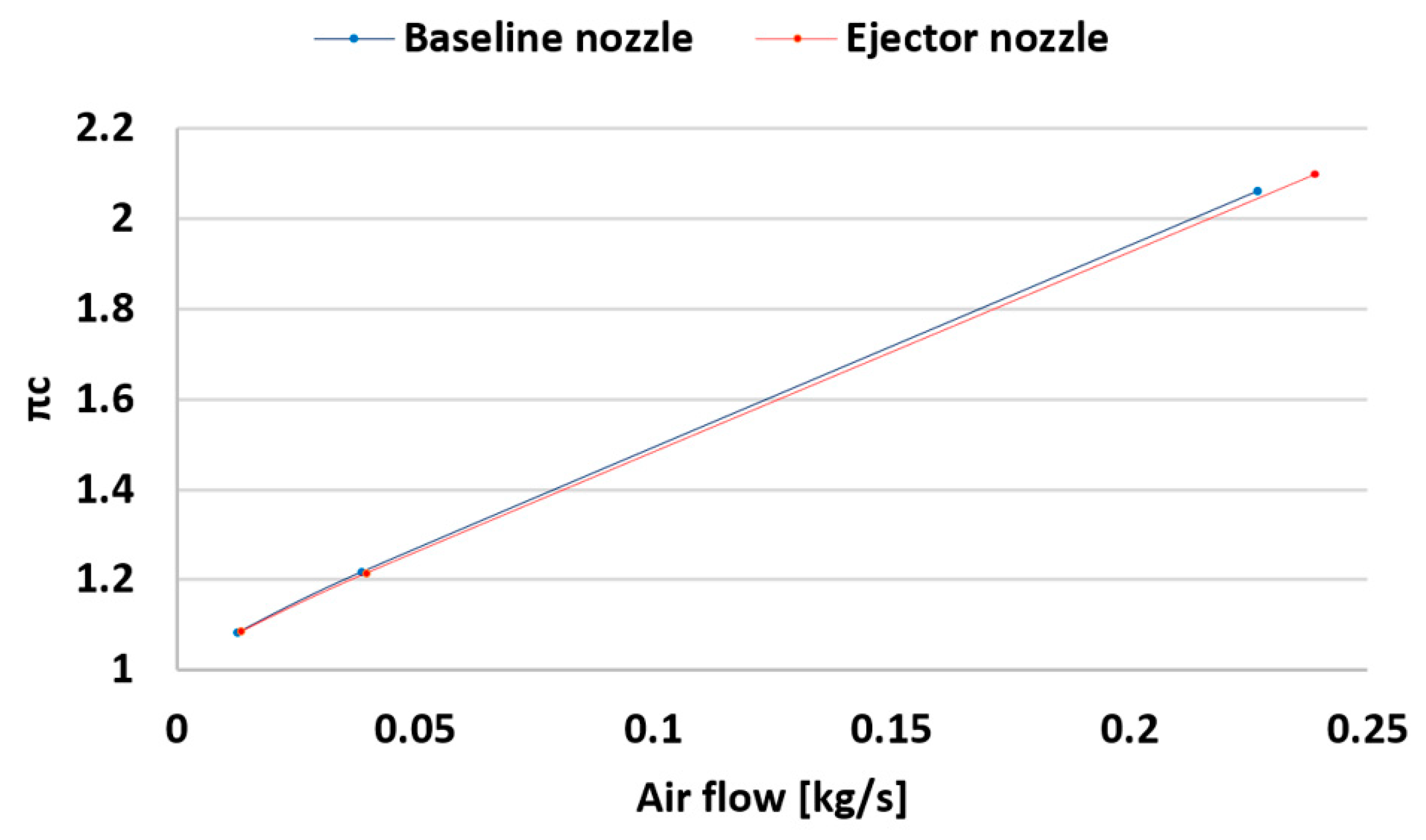
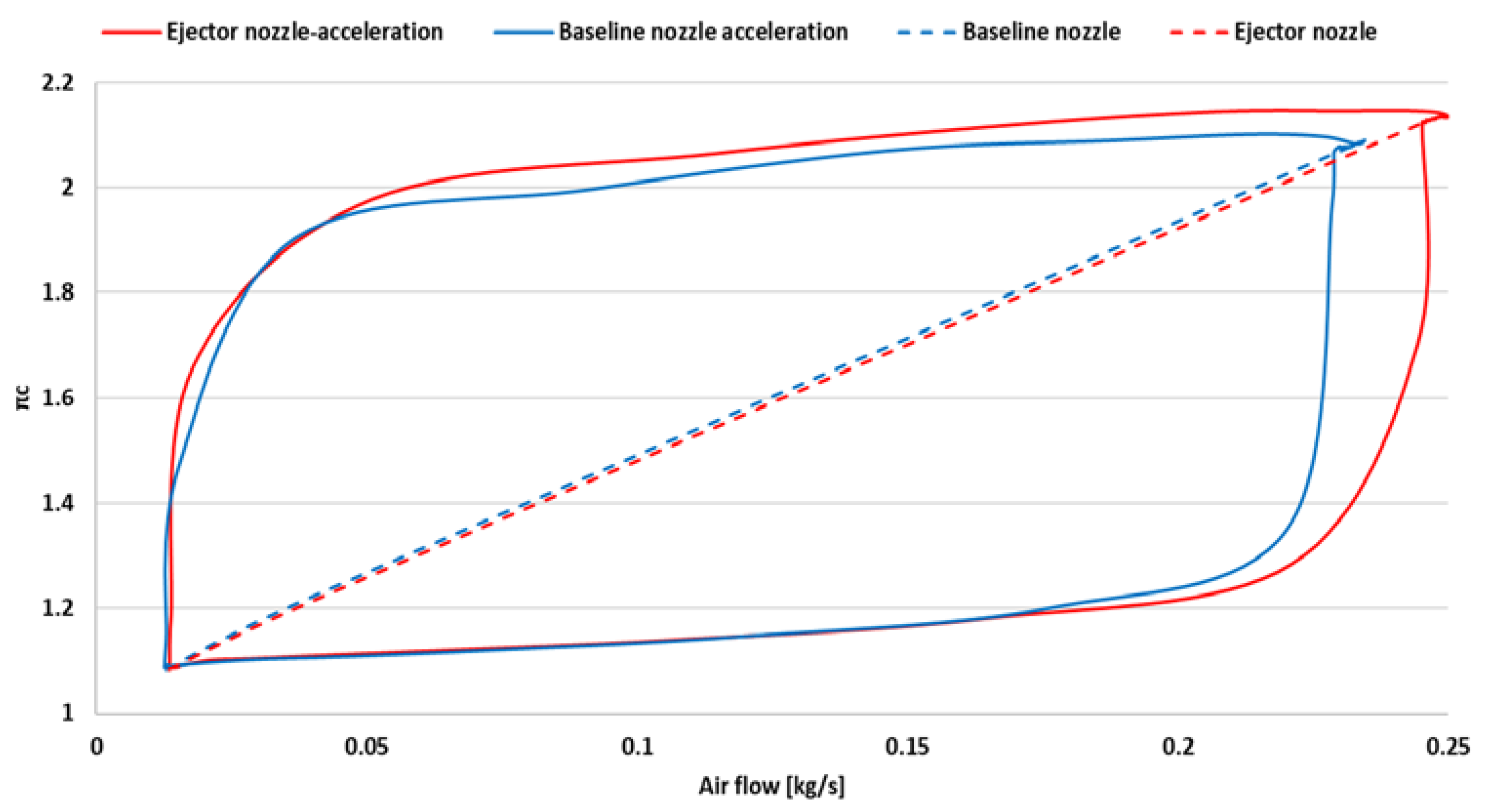
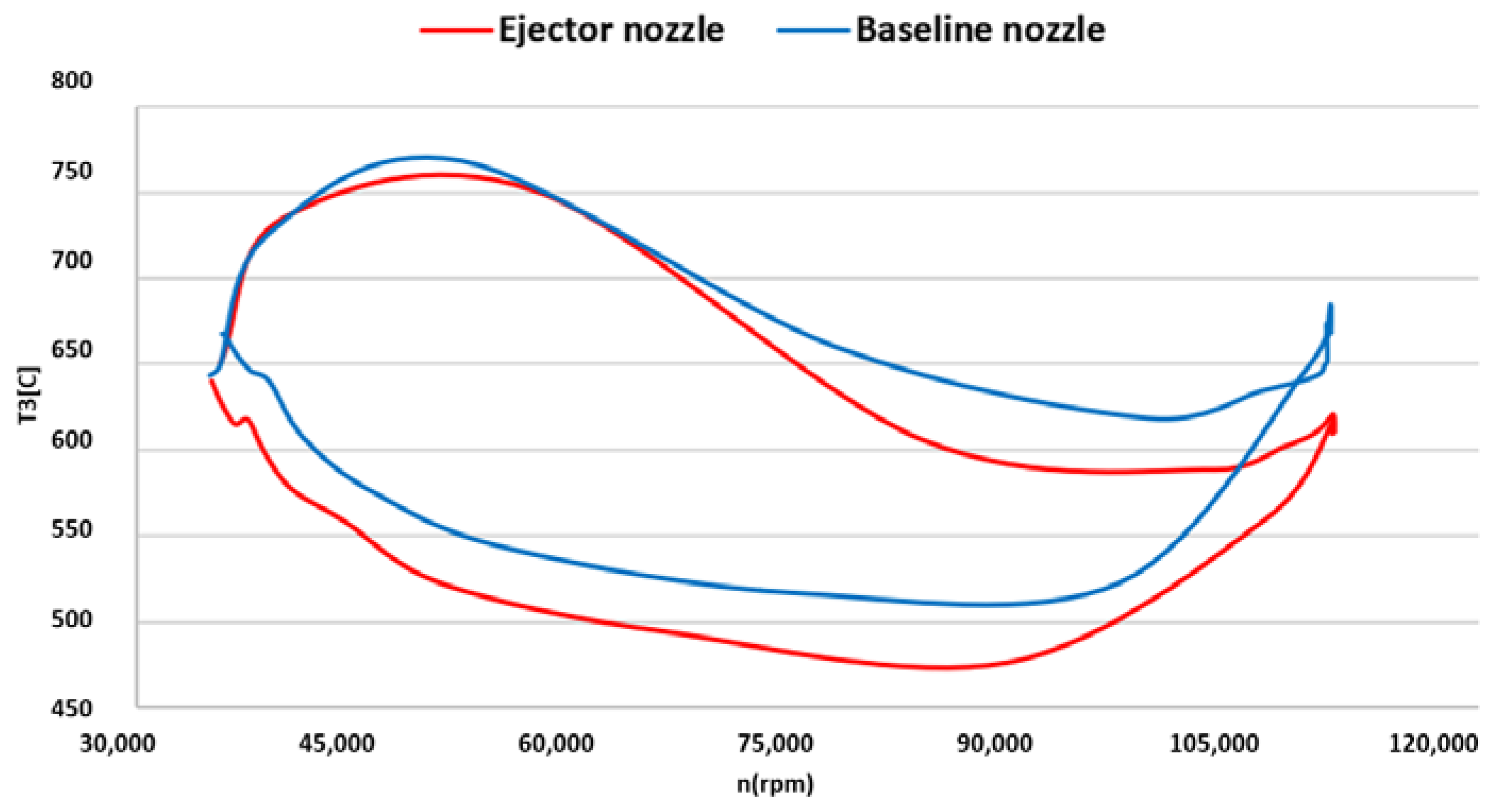

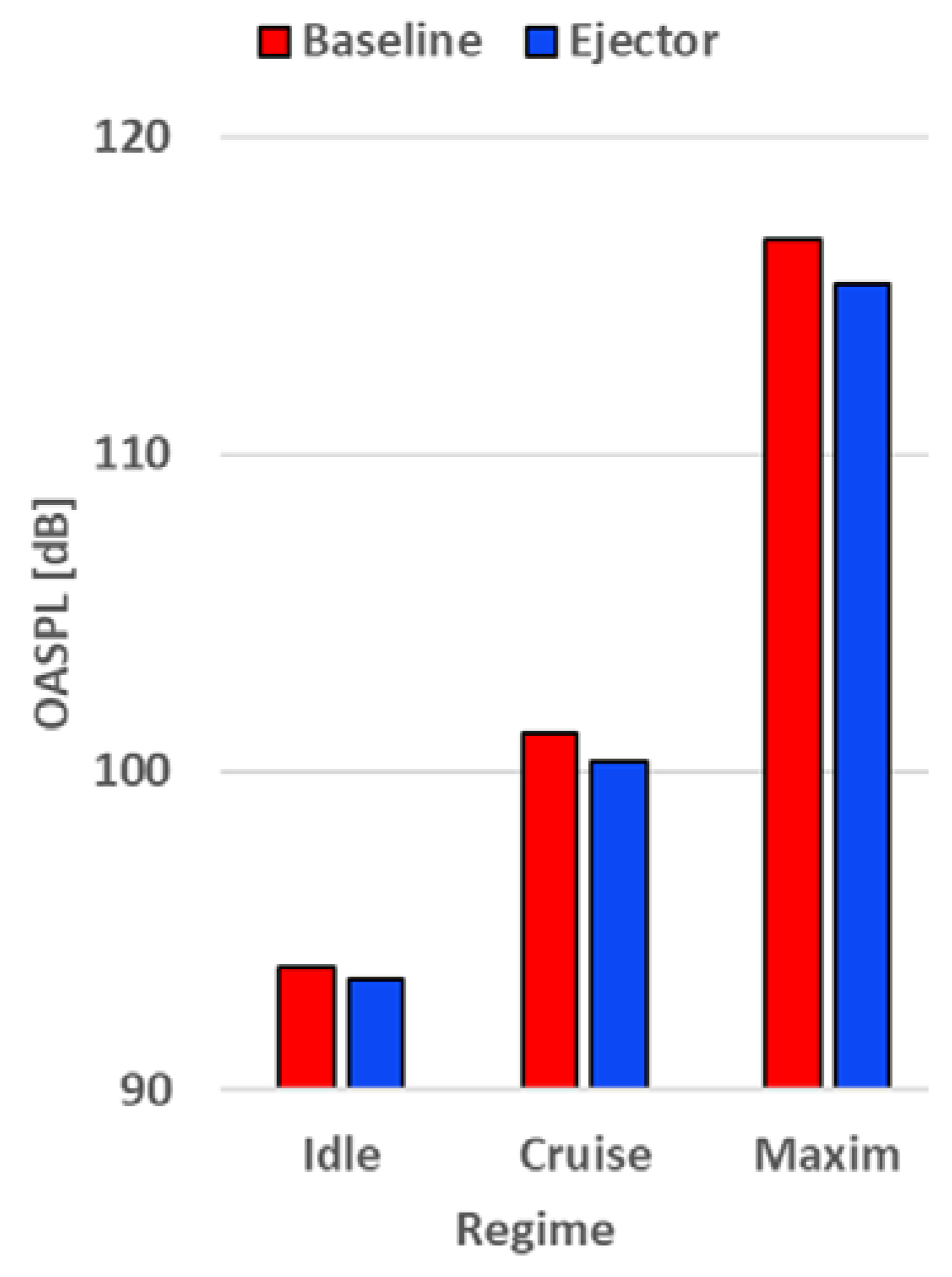
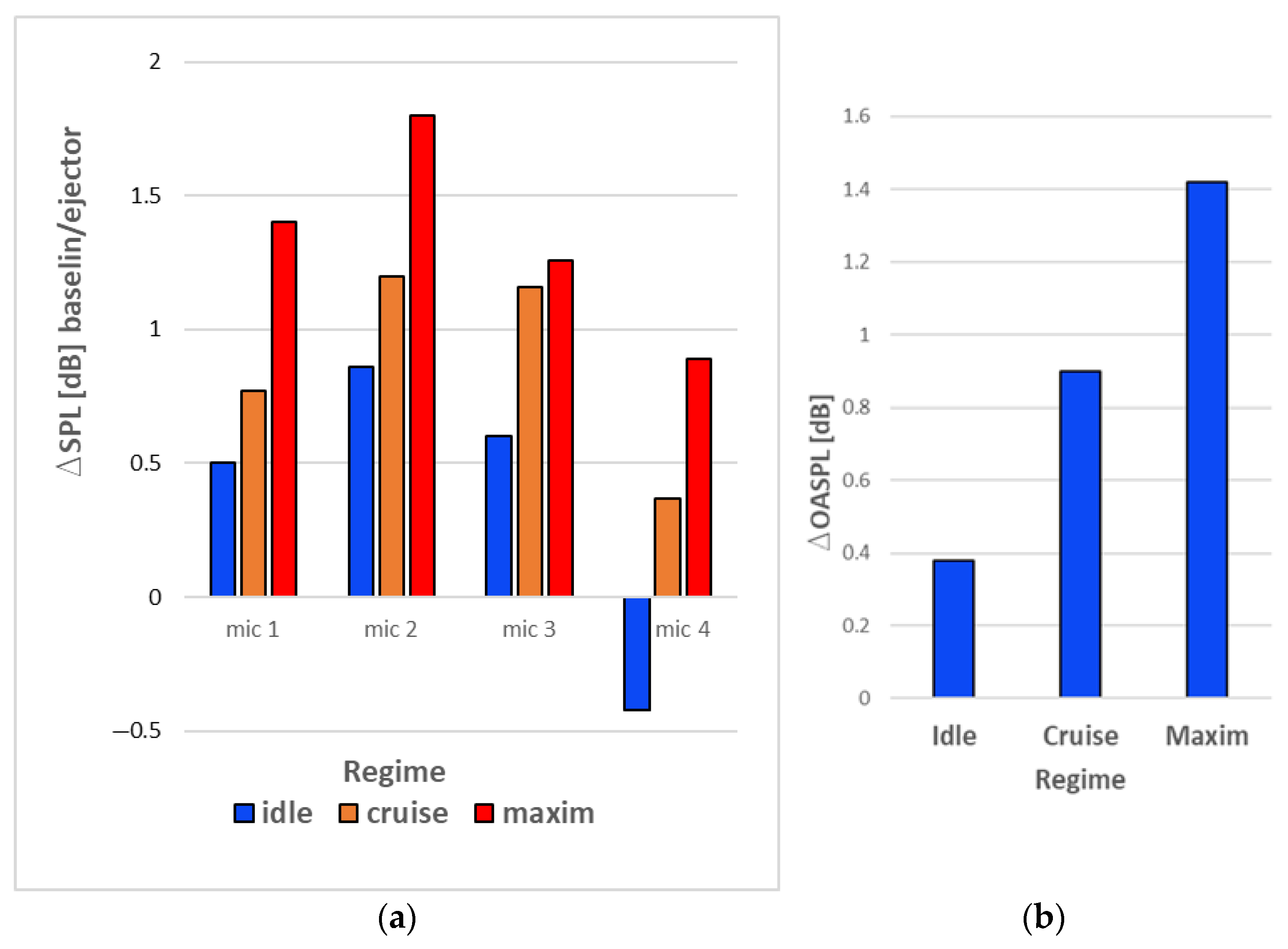
| Regime Speed n (rpm) | Nozzle Type | T2 [K] | T3 [K] | πc | Qc [L/h] | F [N] | S [Kg/Nh] | ηc [%] | |
|---|---|---|---|---|---|---|---|---|---|
| 1 | Idle 35,000 | baseline | 23.4 | 637.0 | 1.083 | 6.88 | 4.54 | 1.213 | 0.72 |
| ejector | 22.0 | 663.1 | 1.085 | 6.59 | 4.87 | 1.083 | 0.86 | ||
| 2 | Cruise 55,000 | baseline | 34.1 | 606.0 | 1.216 | 10.19 | 13.32 | 0.612 | 0.83 |
| ejector | 32.4 | 587.2 | 1.215 | 9.89 | 13.54 | 0.584 | 0.90 | ||
| 3 | Maxim 110,000 | baseline | 102.0 | 655.2 | 2.059 | 22.00 | 72.93 | 0.241 | 0.76 |
| ejector | 88.2 | 600.6 | 2.098 | 21.82 | 75.83 | 0.230 | 0.93 | ||
| Regime/Speed n (rpm) | Nozzle Type | Mic 1 (dB) | Mic 2 (dB) | Mic 3 (dB) | Mic 4 (dB) | |
|---|---|---|---|---|---|---|
| 1 | Idle 35,000 | baseline | 93.46 | 94.00 | 94.33 | 93.49 |
| ejector | 92.96 | 93.14 | 93.73 | 93.91 | ||
| 2 | Cruise 55,000 | baseline | 101.33 | 101.54 | 101.50 | 100.47 |
| ejector | 100.56 | 100.34 | 100.34 | 100.10 | ||
| 3 | Maxim 110,000 | baseline | 118.16 | 117.72 | 115.89 | 114.19 |
| ejector | 116.76 | 115.92 | 114.63 | 113.30 | ||
Disclaimer/Publisher’s Note: The statements, opinions and data contained in all publications are solely those of the individual author(s) and contributor(s) and not of MDPI and/or the editor(s). MDPI and/or the editor(s) disclaim responsibility for any injury to people or property resulting from any ideas, methods, instructions or products referred to in the content. |
© 2023 by the authors. Licensee MDPI, Basel, Switzerland. This article is an open access article distributed under the terms and conditions of the Creative Commons Attribution (CC BY) license (https://creativecommons.org/licenses/by/4.0/).
Share and Cite
Cican, G.; Frigioescu, T.-F.; Crunteanu, D.-E.; Cristea, L. Micro Turbojet Engine Nozzle Ejector Impact on the Acoustic Emission, Thrust Force and Fuel Consumption Analysis. Aerospace 2023, 10, 162. https://doi.org/10.3390/aerospace10020162
Cican G, Frigioescu T-F, Crunteanu D-E, Cristea L. Micro Turbojet Engine Nozzle Ejector Impact on the Acoustic Emission, Thrust Force and Fuel Consumption Analysis. Aerospace. 2023; 10(2):162. https://doi.org/10.3390/aerospace10020162
Chicago/Turabian StyleCican, Grigore, Tiberius-Florian Frigioescu, Daniel-Eugeniu Crunteanu, and Laurentiu Cristea. 2023. "Micro Turbojet Engine Nozzle Ejector Impact on the Acoustic Emission, Thrust Force and Fuel Consumption Analysis" Aerospace 10, no. 2: 162. https://doi.org/10.3390/aerospace10020162
APA StyleCican, G., Frigioescu, T.-F., Crunteanu, D.-E., & Cristea, L. (2023). Micro Turbojet Engine Nozzle Ejector Impact on the Acoustic Emission, Thrust Force and Fuel Consumption Analysis. Aerospace, 10(2), 162. https://doi.org/10.3390/aerospace10020162







